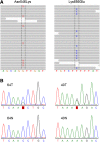Activating FGFR1 Mutations in Sporadic Pheochromocytomas
- PMID: 29159601
- PMCID: PMC5762800
- DOI: 10.1007/s00268-017-4320-0
Activating FGFR1 Mutations in Sporadic Pheochromocytomas
Abstract
Introduction: Pheochromocytomas are neuroendocrine tumors of the adrenal glands. Up to 40% of the cases are caused by germline mutations in one of at least 15 susceptibility genes, making them the human neoplasms with the highest degree of heritability. Recurrent somatic alterations are found in about 50% of the more common sporadic tumors with NF1 being the most common mutated gene (20-25%). In many sporadic tumors, however, a genetic explanation is still lacking.
Materials and methods: We investigated the genomic landscape of sporadic pheochromocytomas with whole-exome sequencing of 16 paired tumor and normal DNA samples and extended confirmation analysis in 2 additional cohorts comprising a total of 80 sporadic pheochromocytomas.
Results: We discovered on average 33 non-silent somatic variants per tumor. One of the recurrently mutated genes was FGFR1, encoding the fibroblast growth factor receptor 1, which was recently revealed as an oncogene in pediatric brain tumors. Including a subsequent analysis of a larger cohort, activating FGFR1 mutations were detected in three of 80 sporadic pheochromocytomas (3.8%). Gene expression microarray profiling showed that these tumors clustered with NF1-, RET,- and HRAS-mutated pheochromocytomas, indicating activation of the MAPK and PI3K-AKT signal transduction pathways.
Conclusion: Besides RET and HRAS, FGFR1 is only the third protooncogene found to be recurrently mutated in pheochromocytomas. The results advance our biological understanding of pheochromocytoma and suggest that somatic FGFR1 activation is an important event in a subset of sporadic pheochromocytomas.
Conflict of interest statement
The authors have no conflict of interest.
Figures



References
Publication types
MeSH terms
Substances
LinkOut - more resources
Full Text Sources
Other Literature Sources
Medical
Research Materials
Miscellaneous

